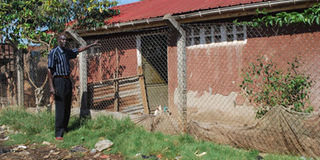Mbale’s Namatala in dire need of toilets

Closed. A public toilet that was constructed in 2014 in Namatala ward, one of the highly populated slum areas in Mbale town, but it has since broken down and closed. PHOTO BY OLIVIER MUKAAY
What you need to know:
Situation. The residents answer nature’s call in polythene bags and dump the waste in the garbage skips.
MBALE. Mbale, once dubbed the cleanest town in Uganda in the early 80s and 90s, has lost a lot of its past glory and is grappling with the problem of lack of toilets, especially in its suburbs. When you visit Namatala slum, a cosmopolitan area in Mbale Municipality, a horrendous odour of human waste permeates through the air.
Many of the homesteads found in the area are made of mud and wattle grass thatched roofs, and have no-pit latrines. The residents instead answer nature’s call in polythene bags and dump the waste in the garbage skips provided by municipal council.
Mr Loumous Zakaliya Papalele, the village chairperson of Muvule cell in Namatala ward, says the challenge of lack of pit-latrines/toilets in the area has existed for long. He says this explains why whenever there is a cholera outbreaks in Mbale District, the first case is reported in Namatala before it spreads to other parts.
Not anymore
Mr Papalele says some three years ago, a public toilet was constructed for them but it has since broken down.
“The toilet they constructed was later closed because the residents couldn’t handle the bills of water and other related issues, which forced it to break down,” he says.
Namatala is the most populated slum in Mbale town, mainly occupied by very low income earners. Mr Papalele explains that the suburb has only 200 pit-latrines, which are in bad shape yet it has a high population density of more than 5,000 households.
He says they have tried to engage the municipal council over the matter but they are yet to intervene. The area is predominantly occupied by Iteso, Karimojong, Bagisu and Acholi, among others.
General problem
The problem of lack of toilets is not limited to Namatala slum, other areas including Nkoma, Mooni, Kiteso, Bujoloto, Mission cell are also facing the same challenge.
The 2014 National Population and Housing Census figures released by the Uganda Bureau of Statistics (UBoS), show that 8 per cent of the population stays in households with no toilet facilities.
“Overall eight per cent of households did not have a toilet facility,” the report states. This (8%) represents 2.7m people in the country.
Yet according to a Sauti wa Wananchi research carried out by Twaweza East Africa, a non-governmental organisation, in December 2017, one in four urban households use “hanging toilets”. The findings further reveal that 20 urban households (5 per cent) use flush toilets, and one in five (19 per cent) use ventilated pit-latrines.
Mr Steven Kisa, the chairperson Nambozo cell in Nkoma ward, Northern Division, says his village has only one toilet which was built under the Uganda Support to Municipal Infrastructure Development Programme.
We have one toilet, which is not enough because the population is really so high in this area being a slum,” he says.
He says people do not want to use the only available toilet because of payment, adding that they instead dump their waste everywhere in polythene bags.
“The residents not only lack knowledge on how to use the toilet but they also do not want to pay the little money to help in cleaning. They instead prefer helping themselves in polythene bags,” Mr Kisa adds.
Acknowledgement
Mr Charles Wadela, the municipal health inspector, acknowledged that toilet coverage in the municipality is worrying especially among the slum dwellers. He says that it has been made worse due to rural-urban migration.
“We have a problem of toilet coverage mostly in slum areas where population is high and everybody struggles ease themselves,” he said.
He however, added that the few land lords who can afford in the slum areas construct pit-latrines instead of toilets.
“The municipality is not supposed to have pit latrines like in the village settings but you find them rampant in the slum areas and in bad shape,” he says.
The public relations officer, Mbale Municipal Council, Mr James Kutosi, blames the residents of failure to use and maintain the few public toilets in their areas.
World Toilet Day was marked yesterday. The day is about taking action to ensure that everyone has a safe toilet by 2030. This is part of Sustainable Development Goal (SDG) 6: sanitation and water.



